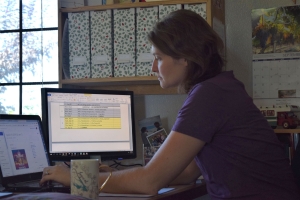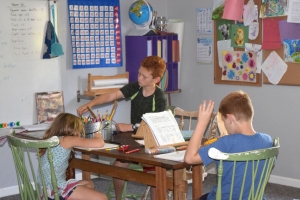She’s too humble to say this, but Angela (Leinberger) Hanson ’07 is living proof that it can be done.
A pastor’s wife, homeschooling mother of four, and tender of bees, chickens, and an orchard of northern California fruit and nut trees, Angela also found time to finish her master’s degree at Martin Luther College.
 To the rest of us, it sounds both idyllic and exhausting. But she did it. And through it all, through the seven years it took to finish, she’s been using what she learns in two classrooms, neither of them in a traditional Lutheran elementary school (LES).
To the rest of us, it sounds both idyllic and exhausting. But she did it. And through it all, through the seven years it took to finish, she’s been using what she learns in two classrooms, neither of them in a traditional Lutheran elementary school (LES).
One is an online classroom facilitated by the devices on her desk and the other a homeschool classroom headquartered at a kitchen table.
It started one day in 2012 when she saw a flood of students pouring out of the public high school in her southern Arizona town and she thought, “It would be fun to teach high school again.” The next day she received an email from MLC Professor Emeritus James Grunwald, asking whether she might be interested in teaching Spanish through Area Lutheran High Schools Online (ALHSO). “I didn’t even realize I was praying for it,” she says.
To become an ALHSO online teacher, she was required to take two graduate courses. Finding that they applied toward an MS Ed degree with an educational technology emphasis, she decided to enroll in the whole program. She took 19 semesters to finish it—just short of the 21 allowed—but that’s not surprising when your life is as busy as this mom’s.
“I started with two boys, ages 3 and 18 months, added a girl at the end of my first course, and then another little girl three years later,” she says. “Most of my coursework was completed after their bedtime and on the weekends, but there were quite a few late nights when projects came due too. We also moved from southern Arizona to northern California after I had finished 21 credits, and somehow it all fit.”
In a way, the long road was the best road. Angela says that progressing slowly through the program gave her time to reflect on what she was learning and integrate it into her online teaching. “I don’t know that I could have used what I learned as effectively if I had been taking two classes at a time for two years straight. Time was definitely on my side.”
And she is definitely putting everything she’s learned to profitable use.
“The way I’ve taught Spanish online has changed with the knowledge I’ve gained from the courses in the program,” she says. “I use a variety of tools to present the content and engage the students. Forums, video lessons, podcasts, shared documents, games, online flashcards, music videos, and—the most important component—weekly video chats. Feedback consistently informs me that chats are the most helpful to learning and understanding the language, and I’m not surprised. Real-time practice, feedback, hearing the pronunciation, having to answer/respond spontaneously—there’s really no substitute for it.”
The more Angela has learned about technology in education, the more careful she is about using it. “You can’t just enroll a student in an online textbook program with a litany of practice exercises and expect them to learn a new language, much less be motivated to continue in it. Social interaction and the relationship between teacher, students, and classmates are essential for developing proficiency, no matter the instructional environment. It becomes a little more challenging to develop relationships and proficiency when the course is online, and that is where knowing the available technology and how to use it becomes important.”
 It’s a matter of balance, she says, for both her online Spanish students and her own children at home. “I believe in using the right tool at the right time according to a child’s development, and my experiences with the younger kiddos leads me to believe that less digital technology is more. If you can use technology to support your teaching, great. If you can use it to take your students to a new level of engagement and collaboration, great. Just keep it in balance with and proportion to their physical and mental developmental needs.”
It’s a matter of balance, she says, for both her online Spanish students and her own children at home. “I believe in using the right tool at the right time according to a child’s development, and my experiences with the younger kiddos leads me to believe that less digital technology is more. If you can use technology to support your teaching, great. If you can use it to take your students to a new level of engagement and collaboration, great. Just keep it in balance with and proportion to their physical and mental developmental needs.”
Keeping things in balance in her own life is important as well. “When you have four (or two, even!) kids in such a short space of time, it can be easy to make being a mom your world—for better or for worse. So it was good for me to have a space of time that was just mine, and to participate in an adult activity with other adults, even if it wasn’t in real time or face to face. It gave me a community.”
To others considering graduate study—whether parents or not—she is nothing but encouraging: “Just do it. You won’t have any regrets. Consider it an investment in not only yourself, but your students and your school too”—whether that school is housed in the LES down the road, the computer monitors in your office, or the homework-strewn table in the next room.
Meet Angela:
MLC: Class of 2007, double major in elementary ed and secondary Spanish
Previous ministry: Christ/St. Peter-Milwaukee, grade 4 (2008-2010)
Family: “My husband, Josh, is also my pastor at Christ Lutheran in Lodi, California. My children are Isaac (9), Micah (8), Elin (6), and Thea (3).”
Church and community: “I help out at church by accompanying worship, directing choir, and leading Mornings with Mommy.”
Hobbies: “Outside of homeschooling my children (which is my favorite!), my current interest is helping my husband renovate a 20-foot RV that we bought last year. We always seem to be traveling to visit family or to go to circuit and district events, and after one too many bad hotel experiences, we decided an RV would better fit our lifestyle and need for independence. We also work outside a lot. We keep about 20 hens for eggs, several bee hives for honey, and have a whole orchard of fruit and nut trees that are always coming ready on a rolling basis and require processing—juicing, drying, canning, freezing, cracking. We have pomegranates, figs, avocados, pecans, walnuts, peaches, cherries, pears, plums, melons, tomatoes, asparagus, strawberries, apples, apricots, almonds, persimmons, grapes, quince, cane berries, sugar cane, olives, greens, squash, pumpkins, and—the latest discovery—a flower off of one of our banana trees. We don’t know if they’ll be edible, but it’s exciting to know that they can fruit this far north.”
Written by Laurie Gauger-Hested





